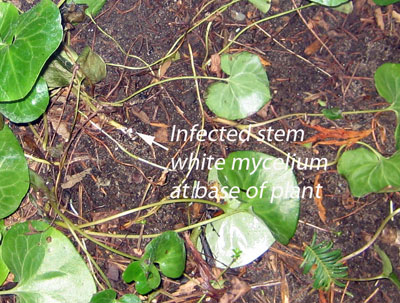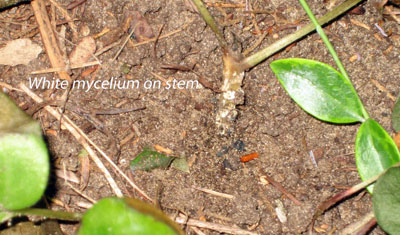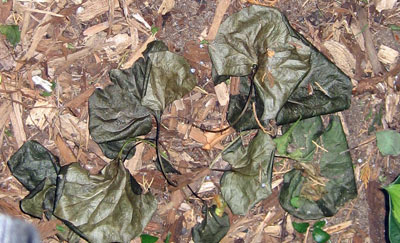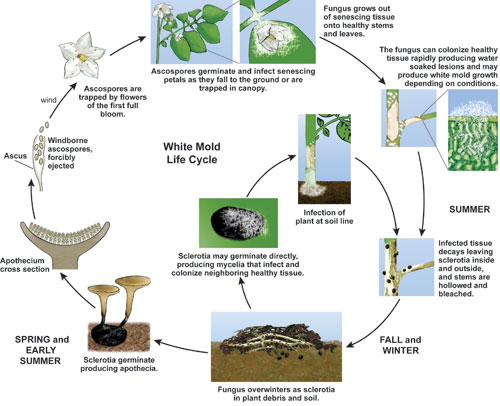White mold showing up on herbaceous perennials
A common vegetable disease, white mold has been reported on herbaceous perennials. Nursery growers should know the symptoms, host range and control measures for managing white mold.
A fungus that causes white mold (Sclerotinia sclerotiorum) has been identified as the culprit in plant death in Asarum species (wild gingers). Over 370 ornamental plant species, field crops, weeds and vegetables in 64 plant families are susceptible to infection from the white mold fungus.
This fungus can cause symptoms that express themselves as a blighting or rotting of any above the soil or below ground part of the plant. Symptoms also are randomly distributed and not always noticed until the plant starts to wilt and die. Look for water-soaked lesions on the stem and the diagnostic telltale white cottony mycelium, which quickly develops around the site of the infection.

Photo 1. Infected stem white mycelium at base of plant.
Photo credit: M. Baker

Photo 2. White mycelium on stem. Photo credit: M. Baker
Plant leaves and flowers will wilt and die and then the stems wilt down, often becoming infected with secondary bacteria. Another diagnostic feature of this disease is the sclerotia or survival structures – hard, black bodies that form inside the stem that are 0.0625 to 0.5 inches in diameter. Sclerotia are present in the stems and fall to the ground when the plant dies. Sclerotia survive extreme cold and dry conditions. These structures survive many years in the soil and can re-infect susceptible plants after they are planted into the infected soil that contains the sclerotia. The sclerotia germinate and develop with a structure that can forcibly discharge spores into the air that are carried by wind currents to plants that, in turn, can be infected if moisture and temperature conditions are ideal (40 to 85 degrees Fahrenheit.) White mold sclerotia germinate in warm and wet condition soil conditions. The fungus will move into the plant tissue and within 10 to 14 days white mycelium can be observed. White sclerotia will then turn grey then black over the season.

Photo 3. Collapsed plant from white mold. Photo credit: M. Baker
Control strategies to avoid infection for white mold can be found in the publication titled White Mold of Vegetables and Ornamentals in the Home Garden by North Dakota State University Extension. A typical white mold disease cycle is shown in Photo 4 (from MSU Extension bulletin E-2989, Michigan Potato Diseases: White Mold).

Photo 4. White mold disease lifecycle.Photo credit: Kirk, Cameron and Wharton, MSU
Specific fungicide recommendations for nursery growers include rotating foliar sprays of fungicides like Pageant Intrinsic or Pageant WDG at 12 to 18 oz on a seven- to 14-day schedule or Cleary’s 3336F 12 to 16 fl oz and other registered products containing thiophanate-methyl. An application of the bio-fungicide Contans WG to the soil after any infected plants are removed from the field has been shown to be effective against sclerotia. Container growers should not reuse any container media that has been infested with white mold-infected plants.
Any plants that you suspect are infested with white mold can be sent to MSU Diagnostic Services for positive identification.
Not all plant species and their varieties and cultivars have been tested for tolerance to Pageant, possible tank-mix combinations of Pageant, pesticide treatments preceding or following those of Pageant and combinations of Pageant with adjuvants or surfactants. Local conditions can also influence plant tolerance and may not match those under which BASF has conducted testing. Therefore, before using Pageant, test the product on a sample of the plant to be treated to ensure that a phytotoxic response will not occur prior to large-scale use.
Dr. Kirk’s work is funded in part by MSU’s AgBioResearch.



 Print
Print Email
Email

